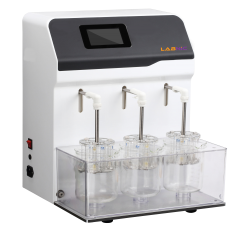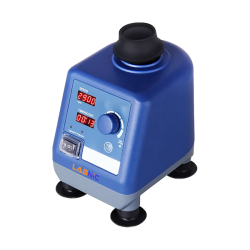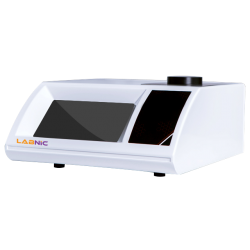Don't wanna be here? Send us removal request.
Text
Drying Oven
A drying oven is a laboratory instrument designed to remove moisture or solvents from samples through the application of heat. It consists of an enclosed chamber with adjustable temperature controls and ventilation systems to facilitate the drying process. Samples are placed inside the oven and subjected to controlled temperatures, typically ranging from ambient temperature to several hundred degrees Celsius, depending on the application.

0 notes
Text
Dry Bath
A dry bath, also known as a dry block heater or a thermal cycler, is a laboratory instrument used to heat samples in various vessels such as tubes, microplates, or vials. Unlike water baths, dry baths use metal blocks to evenly distribute heat to the samples without the need for liquid immersion. They are commonly used in molecular biology, biochemistry, and microbiology applications for tasks such as DNA amplification (PCR), enzyme reactions, and incubation of samples at specific temperatures.

0 notes
Text
Dry Bath Incubator
A dry bath incubator is a laboratory instrument used to provide controlled heating or cooling to samples in tubes or microplates. Unlike traditional water baths, dry bath incubators use metal blocks with wells or slots to hold sample vessels, such as tubes or plates. These metal blocks can be heated or cooled to specific temperatures, allowing precise temperature control for incubating or reacting samples.

0 notes
Text
Dissolved Oxygen Meter
A dissolved oxygen meter is a handheld or benchtop device used to measure the concentration of dissolved oxygen in water or other liquids. It typically consists of a probe with an oxygen-sensitive electrode and a meter that displays the oxygen concentration in units such as milligrams per liter (mg/L) or parts per million (ppm). Dissolved oxygen meters are widely used in environmental monitoring, aquaculture, wastewater treatment, and research to assess water quality, oxygen levels, and the health of aquatic ecosystems.

0 notes
Text
Dissolution Samplers
Dissolution samplers are crucial instruments used in pharmaceutical quality control to collect samples during dissolution testing. They are designed to withdraw aliquots of the dissolution medium at specific time intervals from dissolution vessels containing solid dosage forms, such as tablets or capsules. These samples are then analyzed to assess the release rate of the active pharmaceutical ingredient(s) from the dosage form. Dissolution samplers help ensure accurate and reproducible results in dissolution testing, which is essential for assessing the performance and quality of pharmaceutical formulations.

0 notes
Text
Disintegration Testers
Disintegration testers are instruments used in pharmaceutical quality control to assess the disintegration time of solid dosage forms, such as tablets, capsules, and suppositories. They consist of a set of individual test stations, each equipped with a basket rack or holder. During the test, the dosage form is placed in the appropriate holder and immersed in a suitable dissolution medium, typically water or simulated gastric fluid. The apparatus agitates the medium, mimicking physiological conditions, and monitors the time it takes for the dosage form to disintegrate into smaller particles.

0 notes
Text
Digital Vortex Mixer
A digital vortex mixer is a laboratory instrument designed to quickly and efficiently mix small volumes of liquids or solutions. It consists of a base unit with a motorized platform that oscillates in a circular motion, creating a vortex within the sample tube or vessel. This motion causes the liquid to circulate rapidly, effectively mixing its contents. Digital controls allow users to adjust the speed and duration of mixing, providing precise control over the mixing process.

0 notes
Text
Digital Ultrasonic Cleaner
A digital ultrasonic cleaner is a device that uses high-frequency sound waves to clean delicate items such as jewelry, eyeglasses, and medical instruments. It typically consists of a tank filled with water or a cleaning solution, and an ultrasonic transducer that generates sound waves. When activated, the transducer produces rapid vibrations in the liquid, creating microscopic bubbles that implode on the surface of the items being cleaned. This process, known as cavitation, effectively removes dirt, grime, and contaminants from hard-to-reach areas without damaging the items.

0 notes
Text
Digital Refractometer
A digital refractometer is a high-precision instrument used to measure the refractive index of transparent substances. It employs advanced optics and electronics to accurately determine how much light is bent as it passes through a sample, providing crucial data for various industries such as food and beverage, pharmaceuticals, and gemology. With features like temperature compensation and digital displays, digital refractometers offer fast and reliable measurements, making them indispensable tools for quality control and research applications.

0 notes
Text
Digital Polarimeter
A digital polarimeter is a scientific instrument used to measure the angle of rotation of polarized light as it passes through optically active substances. It consists of a light source, polarizer, sample tube, analyzer, and detector. The sample tube holds the substance being tested, and the polarizer and analyzer are positioned in such a way that the intensity of light passing through the sample can be measured at different angles. By analyzing how the intensity changes with angle, the polarimeter can determine the angle of rotation caused by the substance's optical activity.

0 notes
Text
Digital Melting Point Meter
A digital melting point apparatus is a laboratory instrument used to determine the melting point of solid substances with high accuracy and precision. It typically consists of a heating block, a sample holder, a digital temperature control system, and a display interface. The sample is loaded into a capillary tube or other suitable holder and inserted into the apparatus. The temperature is gradually increased, and the melting point is detected either visually or automatically using a built-in detection system.

0 notes
Text
Digital Dry Bath
A digital dry bath is a laboratory device used to provide precise and controlled temperature conditions for samples without the need for water or liquid immersion. It typically consists of a heating block or chamber with interchangeable heating modules that accommodate various tube sizes or plates.

0 notes
Text
Cube Ice Maker
A cube ice maker is a compact appliance commonly used in homes, offices, and small businesses to produce ice cubes. It operates by freezing water in a tray, then ejecting the formed ice cubes into a storage bin for later use. These machines offer convenience and efficiency for keeping beverages chilled and are available in various sizes and capacities to suit different needs.

0 notes
Text
Cryostat Microtome
A cryostat microtome is a sophisticated laboratory instrument designed for the precise sectioning of frozen tissue samples. Combining freezing capabilities with precision cutting, it allows researchers and pathologists to obtain thin slices of tissue for histological examination under a microscope. This device plays a crucial role in various medical and scientific fields, enabling the study of tissue morphology, pathology, and cellular structures. Its advanced features include temperature control, adjustable cutting thickness, and ergonomic design, ensuring efficient and accurate tissue sectioning for research and diagnostic purpose.

0 notes
Text
Cryogenic Freezer
A cryogenic freezer is a specialized storage device designed to maintain extremely low temperatures, typically below -150°C (-238°F), using liquefied gases such as nitrogen or helium. These freezers are crucial for preserving biological samples, tissues, cells, and other temperature-sensitive materials at ultra-low temperatures to maintain their viability and integrity over extended periods.

0 notes
Text
Cooling Incubator
A cooling incubator is a specialized piece of laboratory equipment designed to provide precise temperature control, typically in a range that extends below ambient temperature. Unlike standard incubators which maintain a constant temperature for culturing organisms or conducting experiments, cooling incubators can lower the internal temperature to create a cooler environment.

0 notes
Text
Conductivity Meter
A conductivity meter is a scientific instrument used to measure the electrical conductivity of a solution. It operates on the principle that ions in a solution can carry electrical current. Conductivity meters are commonly used in various fields such as chemistry, environmental science, agriculture, and water quality monitoring to assess the concentration of dissolved ions, the purity of water, and the effectiveness of chemical processes. They typically consist of electrodes, a conductivity cell, and electronic circuitry to measure and display conductivity values.

1 note
·
View note